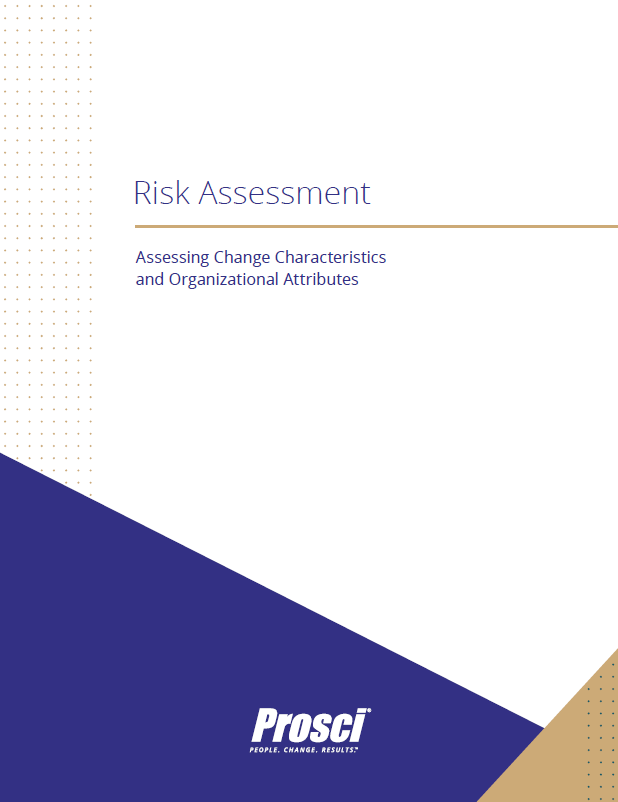B. Define Impact
Introduction
Define Impact helps bring the change into focus at the individual level and provide clarity on what adoption and usage looks like so you can drive improved results and outcomes. By defining impacts, you can understand the beliefs and feelings that people have about the change, enabling you to identify areas of support and resistance. Engaging directly with the impacted people and groups can be very helpful in gaining deeper insight into impact and can also be a powerful way to encourage people to participate fully in the change process.
Define Impacted Groups
We define impacted groups by identifying and creating an inventory of people/groups impacted by the change. Below are the two main impacted groups of the legal merger:
| Impacted Group | Number in Group | Definition of Adoption & Usage | Unique Considerations | Anticipated Resistance | Tactics to Address Resistance | Y/T Status | Aspects Impacted | Degree of Impact | Awareness | Desire | Knowledge | Ability | Reinforcement | Barrier Point |
|---|---|---|---|---|---|---|---|---|---|---|---|---|---|---|
People Leaders and ET | 150 |
|
|
|
| No | TBD | TBD | 4 | 3 | 2 | 2 | 2 | Desire |
Individual Contributors | 650 |
|
|
|
| No | TBD | TBD | 3 | 2 | 2 | 2 | 2 | Awareness |
Assess Change Impact
We assess change impact by using the 10 Aspects of Change Impact to identify the type and degree of change impact for each group. Below are the Change Impact Assessments for the two impacted groups above - People Leaders and ET; Individual Contributors
People Leaders AND Individual Contributors Change Impact
The below table describes the 10 different aspects that this change may impact, what yesterday looks like for each aspect, and how the change, in our case, the merger, will affect the aspect. Also, we rate the degree of impact on each aspect Impacted
Aspect Impacted | Yesterday (before the change) | Tomorrow (after the change) | Degree of Impact (0-5) |
|---|---|---|---|
Process:The actions or steps taken to achieve a defined end or outcome. Example: steps in the client engagement process and actions taken to capture data in a cloud-based CRM system. |
|
| 0 |
Systems:A combination of people and automated applications organized to meet a set of objectives. Example: the introduction of a new cloud-based CRM solution to manage and analyze client interactions and data throughout the customer lifecycle. | Current tools and programs we use:
|
Will leaders need to learn new tools due to the merger? | 2 |
Tools:An item or implement used for a specific purpose; can be a physical object such as a mechanical tool or a technical object such as a web authoring tool or software program. Example: a conversion tool to move data from one CRM solution to another one mapping data as needed. |
|
| 2 |
Job Roles:A description of what a person does including competencies essential to performing well in that job capacity. Example: the client services role responsible for engaging directly with clients. |
|
| 0 |
Critical Behaviors:Vital or essential response of an individual or group to an action, environment, person or stimulus. Example: the actions of a client services associate based on client needs expressed including engagement with other team members to collaborate on solutions. |
|
There will be a need to break down silos, get to know each other more, especially between RS and SASD. More collaboration will be needed? | 3 |
Mindset/Attitude/Beliefs:A mental inclination, disposition or frame of mind reflected in behaviors. Example: the transition from a transactional mode of financial services engagement to one built on relationships with the mindset of improving client retention and advocacy. |
|
| 4 |
Reporting Structure:The authority relationships in a company or organization; who reports to whom. Example: the move from regional sales teams to a global client services team with a different executive leader. |
|
| 3 |
Performance Reviews:The process and indicators of how performance is measured and assessed relative to objectives. Example: the introduction of specific client retention and advocacy objectives for client services associates. |
|
| 0 |
Compensation:The amount of the monetary and non-monetary pay provided in return for work performed. Example: the commission structure and bonus plan for client services associates. |
|
| 0 |
Location:A physical geographical place that provides facilities for a stated purpose. Example: the consolidation of all client services associates to one floor of the building instead of three separate locations by region. |
|
| 0 |
Risk Assessment
The risk assessment is a tool that measures

